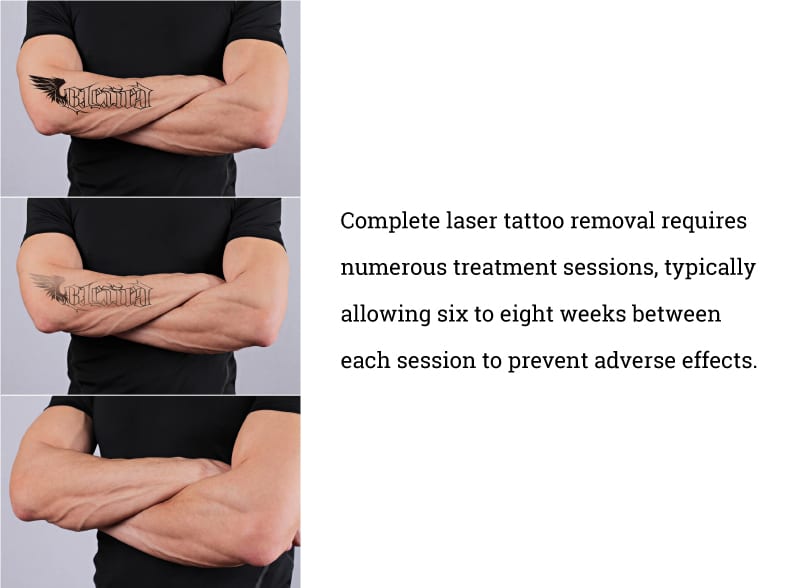People get tattoos for a variety of reasons. Some do it to represent something they feel strongly about, others do it because they find tattoos cosmetically appealing, and some people even do it based on a dare. Regardless of the reason, over time some people find themselves regretting the tattoo altogether. In fact, in 2015 The Harris Poll found that of the 47% of Americans ages 18 to 29 with at least one tattoo, 23% of them regret getting their tattoo! While tattoos were once considered to be permanent, advances in tattoo removal procedures have made it possible to completely remove undesired ink.
Advances in laser tattoo removal
Before the development of tattoo removal with lasers, procedures included dermabrasion, trichloroacetic acid (TCA), salabrasion, cryosurgery, and excision. Initially, laser tattoo removal was performed with continuous wave lasers, followed by Q-switched lasers, which became commercially available in the early 1990s. (Wikipedia) The American Academy of Dermatology states that “lasers have largely replaced other tattoo-removal methods.”
Art of Dermatology utilizes the FDA-approved PicoSure®, the world’s first safe and effective picosecond aesthetic laser. PicoSure® uses the latest laser technology to remove all colors and hues of tattoos by delivering ultra-short picosecond pulses of energy into the skin. These pulses create a PressureWave™ that targets the pigments of tattoo ink while avoiding unmarked skin. The PicoSure® laser breaks down the ink into tiny particles, which are then eliminated from the body by the immune system. Even stubborn dark blue and green inks, as well as previously-treated recalcitrant tattoos, can be removed with PicoSure®.

What to expect during laser tattoo removal
Laser tattoo removal has been described as having a similar feeling to the process of getting the tattoo or like the snapping of a rubber band against the skin. For those with a lower pain threshold, topical anesthetic creams are sometimes offered to help numb the area prior to the procedure. Fortunately, PicoSure® treatment sessions are quick, only requiring about 10 minutes for an average size tattoo.
After each treatment session it is suggested to minimize sun exposure and to wear a sunscreen of at least SPF30. The reason is based on the mechanism behind laser tattoo removal. Normally, the cells of the skin protect against the sun’s harmful radiation by producing melanin, a dark brown to black pigment that causes skin to tan. Since Picosure targets melanin to remove excess pigment, treated skin will be more vulnerable to sun damage. The American Academy of Dermatology recommends protecting the treated area of skin for at least three months.
More than one session for tattoo removal may be required
The way a tattoo artist creates a tattoo is by injecting and layering insoluble ink into the dermis (the middle layer of skin). The ink lasts because the body is not able to absorb these pigments.
Laser removal techniques can only safely remove one layer of ink at a time. Complete laser tattoo removal requires numerous treatment sessions, typically allowing six to eight weeks between each session to prevent adverse effects. The time between treatments is dependent on how quickly the skin can absorb and eliminate the shattered pigment particles.

With PicoSure®, however, fewer treatments than traditional lasers are necessary for excellent results. The total number of treatments required to fully remove the tattoo is dependent on variables such as the size of the tattoo, location on the body, ink characteristics, and lifestyle habits.
The possible side effects of tattoo removal procedures
With laser tattoo removal procedures, possible side effects include scarring, changes in the skin’s texture, burning, and light or dark spots on the skin. The light or dark spots that may appear will typically disappear in 6 to 12 months. (AAD) When proper laser tattoo removal techniques are used, however, side effects are extremely rare. The laser technology of PicoSure®, for example, is designed with safety as a priority and incidents of scarring and other side effects are rare.
See a dermatologist for tattoo removal procedures
Dermatologists have medical training in the techniques of tattoo removal procedures. They also prioritize the safety and health of your skin. Although some tattoo artists and aestheticians offer tattoo removal treatments, they lack the medical training and perspective of dermatologists. The American Academy of Dermatology reports that side effects from tattoo removal procedures are more common when performed by someone who lacks medical training.














Leave A Comment